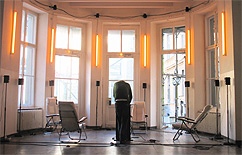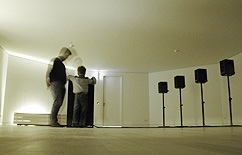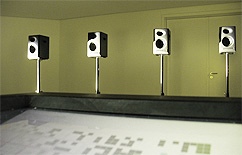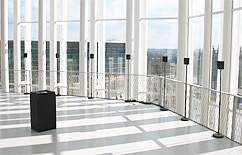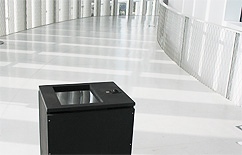A room with eight speakers forming a dotted line. The visitor in front of a terminal, a black monolith, a focus point, equipped with a trackpad and a screen. The visitor placing elements on a grid, placing squares on a screen, shaping a virtual space transformed into an audible space, transmitted via the internet to define the same space again at a different space, at a different physical location. Parallel worlds.
On the screen a matrix of 15 horizontal blocks of 32 squares is displayed. The 32 squares of each row are scanned by a travelling dot. The horizontal position maps events to one of the eight speakers. The visitor can click on each square and mark it. Marking a square on screen means marking a space in the room. The travelling dot hits the space on the screen, creates a sound in the room. The moving dot plus the marked square creates patterns in space and patterns in time.
The installation exists simultaneously in two physical locations.
Both spaces are linked. The virtual space defined on the screen
appears on both terminals and can be modified at the same time by two
people. In both locations the same actions result in the same sonic
experience. The internet acts as the wormhole. Two spaces are mapped
to each other. Data travels faster than sound allowing two physical
locations to merge into one virtual space. Each location is the
exact mirror of the other one.
The installation encourages visitors to interact, to create spaces and rhythm
together with an invisible counterpart somewhere else.
The presence of the other side of the world is indicated by a clock
telling since when the last visitor is playing with the
installation. Each side is made aware of the existence of the other
side. Interaction follows simple social principles. One person
creates, the other is observing, destroying, overwriting,
interacting, contributing, playing with or against each other.
Actions from both terminals have different colors on screen. The presence of the other side: an invasion of a new color. Is the other side a human being or a machine? The answer becomes obvious after playing for a short while. The installation becomes a social laboratory. Is the other side helping to build up an interesting sonic structure, is it willing to collaborate or just invading the space, deleting all your contributions, filling up all space with its own color?
[Find some screenshots in image gallery]
The empty grid wants to be filled. The warm background sounds created by the machine during idle times gets lower and lower the more spaces on the grid are marked. The rhythm gets more dense and louder. The space is filled with sounds, like building a random city of buildings. After a while this gets boring. People start to delete marks again, finding more interesting structures, opening up spaces again, discovering that emptiness is a value. that interactions get more powerful if the structure is simple and elegant. The chaos vanishes, the results become musical.
Image right: The terminal at TESLA Berlin
